

Visualize Temple by MindMixer. At ASU, sustainable procurement isn't just an academic exercise. Arizona State University (ASU) isn't just a leader in the academics of sustainable business, it's also one of the most aggressive – and principled – organizations when it comes to embedding those principles into its operations.

A driving force behind the American College & University Presidents Climate Commitment, ASU strives to be carbon-neutral for its Scope 1, 2 and non-transportation Scope 3 emissions by 2025. It also aims to eliminate 90 percent of the solid waste generated on campus by 2015, and to halve its water consumption and elimimate all campus water effluent by 2020. The university has made substantial investments in emerging technologies toward this end. As of late July, for example, close to 21 megawatts (MW) of solar panels are powering four campus locations and the ASU Research Park. ASU's solar panel installation. Not Just How Well….but How, as Well. It’s understood that print buyers are concerned with quality and price, and printers are concerned with efficiency and profitability; but a recent presentation by Martine Padilla made me realize that these goals are not only not in conflict, but are in fact complimentary parts of a common goal.

Martine’s presentation, given at this year’s DSCOOP Conference, is nearly an hour long, and after listening several time and taking notes, I’m still turning the message over in my mind, so all I can offer here is the very briefest encapsulation; but please check it our or read Martine’s synopsis, because I think it addresses issues that are beginning to resonate in our industry on multiple levels. Untitled. 13 Hot Books from Sustainability Thought Leaders. Second Nature Applauds the Unprecedented Progress Made by Signatories. ACUPCC signatories continue their ongoing, extraordinary efforts to publicly report on progress made to eliminate operational greenhouse gas (GHG) emissions and to provide the education, research and community engagement to enable the rest of society to do the same.
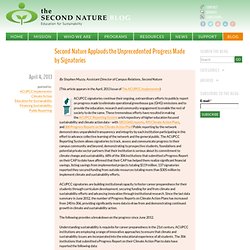
These tremendous efforts have resulted in making the ACUPCC Reporting System a rich repository of higher education focused sustainability and climate action data – with 1853 GHG reports, 495 Climate Action Plans, and 306 Progress Reports on the Climate Action Plan! Sustainability: Not So Clear Cut. By Phil Riebel The topic of using recycled fiber in printing papers is being discussed more actively within the Two Sides network these days due to the notion that “more recycled content in printing papers is better for the environment”.
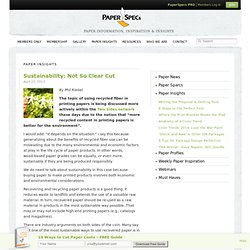
I would add: “it depends on the situation.” I say this because generalizing about the benefits of recycled fiber use can be misleading due to the many environmental and economic factors at play in the life cycle of paper products. eQ Journal 5: Sappi Fine Paper - eQ Journal 005 - Rethinking Recycling. For decades, recycled content was the “go-to” attribute for making environmentally preferable materials — in both paper and other industries.

It seems intuitive that if recycling is good for the environment, then using recycled fiber must also be good. And if a little bit of something is good, then more must be better. However, as the science of sustainability has matured, we have come to view issues more holistically — to approach complex concepts with systems thinking. Using Recycled Paper in Magazines Protects the Environment. New Life Cycle Analysis study shows that in 14 of 14 environmental impact categories studied there is an environmental benefit to using recovered fiber as a substitute for virgin tree fiber.A study commissioned by the National Geographic Society found overwhelming environmental benefits to using paper containing recycled content, it was announced today.
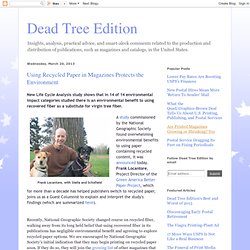
Frank Locantore, Project Director of the Green America Better Paper Project, which for more than a decade has helped publishers switch to recycled paper, joins us as a Guest Columnist to explain and interpret the study's findings (which are summarized here). Recently, National Geographic Society changed course on recycled fiber, walking away from its long held belief that using recovered fiber in its publications has negligible environmental benefit and agreeing to explore recycled paper options.
We are encouraged by National Geographic Society’s initial indication that they may begin printing on recycled paper soon. Relative Impacts. Emotion Is Currency: A Five-Point Plan for Effective Sustainability Communications. The Rainforest Alliance's "Follow the Frog" video has over 1,150,000 views on YouTube | Image credit: Rainforest Alliance "How will it deliver value?
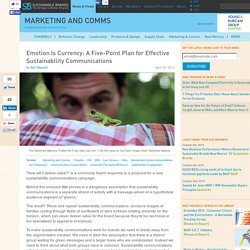
" is a commonly heard response to a proposal for a new sustainability communications campaign. Behind this innocent little phrase is a dangerous assumption that sustainability communications is a separate strand of activity with a message aimed at a hypothetical audience segment of 'greens.' The result?
Follow the Frog. Demystifying Biobased Products Key to Marketing Success. A version of this post first appeared in Bioplastics Magazine, May/June 2012.
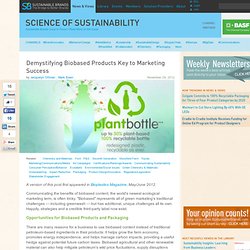
Communicating the benefits of biobased content, the world's newest ecological marketing term, is often tricky. "Biobased" represents all of green marketing's traditional challenges — including greenwash — but has additional, unique challenges all its own. Happily, strategies and a credible third-party label now exist. Opportunities for Biobased Products and Packaging There are many reasons for a business to use biobased content instead of traditional petroleum-based ingredients in their products: It helps grow the farm economy, promotes energy independence, and helps manage carbon impacts, providing a useful hedge against potential future carbon taxes. How Green Is Print? News, Resources, Events, and Assessment Tools for the Campus Sustainability Community. Cradle To Cradle Products Innovation Institute. DDB Canada. Data Centers + environmental impact.